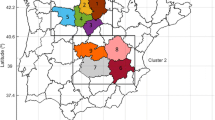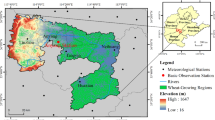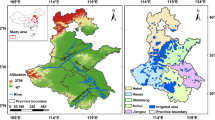Abstract
Due to the impact of drought on crop yield, the aim of this research is the susceptibility assessment of winter wheat, barley and rapeseed species to drought using Generalized Estimating Equations (GEE) and Cross-Correlation Function (CCF). For this objective, the climatic data of 10 synoptic stations in Iran from 1968 to 2017 (i.e., 50 years) were used. Then, the AquaCrop model was adopted to simulate annual yield (Ay) of the above-mentioned species. Also, the standardized precipitation evapotranspiration index (SPEI) was applied to assess drought conditions in selected constant and progressively increasing reference time periods, including 1-month, 3-month, 6-month and 12-month time scales (27 reference time periods) starting in October. For evaluating the accuracy of the GEE model, the correlation coefficients (CC) between simulated and predicted annual yields in selected species through the AquaCrop model and GEE model were used, respectively. The accuracy test of the GEE model showed that the CC between simulated and predicted annual yield of barley almost in all stations and all-time scales were significant at 0.01 level. Only in Birjand and Kerman stations the CC between simulated and predicted annual yield were significant at 0.05 level in 3.7% and 66.67% of time scales, respectively. Based on the GEE and CCF models in all stations, the susceptibility of rapeseed to drought was more than that of wheat, and the susceptibility of wheat was more than that of barley.





Similar content being viewed by others
Data Availability
The data used in this research are available by the corresponding author upon reasonable request.
References
Ayantobo OO, Li Y, Song S (2019) Multivariate drought frequency analysis using four-variate symmetric and asymmetric Archimedean copula functions. Water Resour Manag 33:103–127. https://doi.org/10.1007/s11269-018-2090-6
Ballinger GA (2004) Using generalized estimating equations for longitudinal data analysis. Organ Res Methods 7(2):127–150. https://doi.org/10.1177/1094428104263672
Barbosa HA, Kumar TL, Paredes F, Elliott S, Ayuga JG (2019) Assessment of Caatinga response to drought using Meteosat-SEVIRI normalized difference vegetation index (2008–2016). ISPRS J Photogramm 148:235–252. https://doi.org/10.1016/j.isprsjprs.2018.12.014
Bhuyan-Erhardt U, Erhardt TM, Laaha G, Zang C, Parajka J, Menzel A (2019) Validation of drought indices using environmental indicators: streamflow and carbon flux data. Agric For Meteorol 265:218–226. https://doi.org/10.1016/j.agrformet.2018.11.016
Chakraborty T (2020) Multi-scale assessment of drought-induced forest dieback (Doctoral dissertation). http://hdl.handle.net/10362/94403
Chen H, Liang Z, Liu Y, Jiang Q, Xie S (2018) Effects of drought and flood on crop production in China across 1949–2015: spatial heterogeneity analysis with Bayesian hierarchical modeling. Nat Hazards 92(1):525–541. https://doi.org/10.1007/s11069-018-3216-0
Chen X, Li Y, Yao N, Li Liu D, Javed T, Liu C, Liu F (2020) Impacts of multi-timescale SPEI and SMDI variations on winter wheat yields. Agric Syst. https://doi.org/10.1016/j.agsy.2020.102955
Danandeh Mehr A, Sorman AU, Kahya E, Hesami Afshar M (2020) Climate change impacts on meteorological drought using SPI and SPEI: case study of Ankara, Turkey. Hydrol Sci J 65:254–268. https://doi.org/10.1080/02626667.2019.1691218
De Martonne E (1926) Aérisme et indice d'aridité. Comptes rendus d’Académie des. Sciences 182:1395–1398
Gao Y, Hu T, Wang Q, Yuan H, Yang J (2019) Effect of drought–flood abrupt alternation on rice yield and yield components. Crop Sci 59:280–292. https://doi.org/10.2135/cropsci2018.05.0319
Ghisletta P, Spini D (2004) An introduction to generalized estimating equations and an application to assess selectivity effects in a longitudinal study on very old individuals. J Educ Behav Stat 29:421–437. https://doi.org/10.3102/10769986029004421
Hamal K, Sharma S, Khadka N, Haile GG, Joshi BB, Xu T, Dawadi B (2020) Assessment of drought impacts on crop yields across Nepal during 1987–2017. Meteorol Appl. https://doi.org/10.1002/met.1950
Hu FB, Goldberg J, Hedeker D, Flay BR, Pentz MA (1998) Comparison of population-averaged and subject-specific approaches for analyzing repeated binary outcomes. Am J Epidemiol 147:694–703. https://doi.org/10.1093/oxfordjournals.aje.a009511
Huang J, Zhuo W, Li Y, Huang R, Sedano F, Su W, Dong J, Tian L, Huang Y, Zhu D, Zhang X (2020) Comparison of three remotely sensed drought indices for assessing the impact of drought on winter wheat yield. Int J Digit Earth 13:504–526. https://doi.org/10.1080/17538947.2018.1542040
Iqbal MS, Singh AK, Ansari MI (2020) Effect of drought stress on crop production. In: Rakshit A, Singh H, Singh A, Singh U, Fraceto L (eds) New Frontiers in stress Management for Durable Agriculture. Springer, Singapore, pp 35–47. https://doi.org/10.1007/978-981-15-1322-0_3
Jalil A, Akhtar F, Awan UK (2020) Evaluation of the AquaCrop model for winter wheat under different irrigation optimization strategies at the downstream Kabul River basin of Afghanistan. Agric Water Manag. https://doi.org/10.1016/j.agwat.2020.106321
Katerji N, Mastrorilli M, Van Hoorn JW, Lahmer FZ, Hamdy A, Oweis T (2009) Durum wheat and barley productivity in saline–drought environments. Eur J Agron 31(1):1–9. https://doi.org/10.1016/j.eja.2009.01.003
Khoshoei M, Safavi HR, Sharma A (2019) Relationship of drought and engineered water supply: multivariate index for quantifying sustained water stress in anthropogenically affected sub-basins. J Hydrol Eng. https://doi.org/10.1061/(asce)he.1943-5584.0001779
Labudová L, Labuda M, Takáč J (2017) Comparison of SPI and SPEI applicability for drought impact assessment on crop production in the Danubian lowland and the east Slovakian lowland. Theor Appl Climatol 128:491–506. https://doi.org/10.1007/s00704-016-1870-2
Leng G, Hall J (2019) Crop yield sensitivity of global major agricultural countries to droughts and the projected changes in the future. Sci Total Environ 654:811–821. https://doi.org/10.1016/j.scitotenv.2018.10.434
Li C, Leal Filho W, Yin J, Hu R, Wang J, Yang C, Yin S, Bao Y, Ayal DY (2018) Assessing vegetation response to multi-time-scale drought across inner Mongolia plateau. J Clean Prod 179:210–216. https://doi.org/10.1016/j.jclepro.2018.01.113
Li X, Sha J, Wang ZL (2019) Comparison of drought indices in the analysis of spatial and temporal changes of climatic drought events in a basin. Environ Sci Pollut R 26:10695–10707. https://doi.org/10.1007/s11356-019-04529-z
Marček T, Hamow KÁ, Végh B, Janda T, Darko E (2019) Metabolic response to drought in six winter wheat genotypes. PLoS One 14:e0212411. https://doi.org/10.1371/journal.pone.0212411
Meise P, Seddig S, Uptmoor R, Ordon F, Schum A (2019) Assessment of yield and yield components of starch potato cultivars (Solanum tuberosum L.) under nitrogen deficiency and drought stress conditions. Potato Res 62:193–220. https://doi.org/10.1007/s11540-018-9407-y
Mousavizadeh SF, Honar T, Ahmadi SH (2016) Assessment of the AquaCrop model for simulating canola under different irrigation managements in a semiarid area. Int J Plant Prod 10(4):425–445. https://doi.org/10.22069/ijpp.2016.3040
Otkin JA, Zhong Y, Hunt ED, Basara J, Svoboda M, Anderson MC, Hain C (2019) Assessing the evolution of soil moisture and vegetation conditions during a flash drought–flash recovery sequence over the south-Central United States. J Hydrometeorol. https://doi.org/10.1175/JHM-D-18-0171.1
Páscoa P, Gouveia CM, Russo A, Trigo RM (2017) The role of drought on wheat yield interannual variability in the Iberian Peninsula from 1929 to 2012. Int J Biometeorol 61:439–451. https://doi.org/10.1007/s00484-016-1224-x
Peña-Gallardo M, Vicente-Serrano SM, Domínguez-Castro F, Quiring S, Svoboda M, Beguería S, Hannaford J (2018) Effectiveness of drought indices in identifying impacts on major crops across the USA. Clim Res 75:221–240. https://doi.org/10.3354/cr01519
Peña-Gallardo M, Vicente-Serrano SM, Quiring S, Svoboda M, Hannaford J, Tomas-Burguera M, Martín-Hernández N, Domínguez-Castro F, El Kenawy A (2019) Response of crop yield to different time-scales of drought in the United States: Spatio-temporal patterns and climatic and environmental drivers. Agric For Meteorol 264:40–55. https://doi.org/10.1016/j.agrformet.2018.09.019
Ramezani M, Babazadeh H, Sarai Tabrizi M (2019) Simulating barley yield under different irrigation levels by using AquaCrop model. J Irrig Sci Eng 41:161–172. https://doi.org/10.22055/jise.2017.20215.1452
Rezazadeh Jodi A, Sattari MT (2016) Performance evaluation of different estimation methods for missing rainfall data. Res Geogr Sci 16:155–176
Samarah NH (2005) Effects of drought stress on growth and yield of barley. Agron Sustain Dev 25:145–149. https://doi.org/10.1051/agro:2004064
Schierhorn F, Hofmann M, Adrian I, Bobojonov I, Müller D (2020) Spatially varying impacts of climate change on wheat and barley yields in Kazakhstan. J Arid Environ. https://doi.org/10.1016/j.jaridenv.2020.104164
Shen Z, Zhang Q, Singh VP, Sun P, Song C, Yu H (2019) Agricultural drought monitoring across Inner Mongolia, China: model development, spatiotemporal patterns and impacts. J Hydrol 571:793–804. https://doi.org/10.1016/j.jhydrol.2019.02.028
Shirshahi F, Babazadeh H, Ebrahimipak N, Zeraatkish Y (2018) Calibration and assessment of AquaCrop model for managing the quantity and time of applying wheat deficit irrigation. Irrig Sci Eng 4:31–44. https://doi.org/10.22055/jise.2018.13451
Shumway RH, Stoffer DS (2017) Time series analysis and its applications: with R examples. Springer. https://doi.org/10.1007/978-3-319-52452-8
Tian L, Yuan S, Quiring SM (2018) Evaluation of six indices for monitoring agricultural drought in the south-Central United States. Agric For Meteorol 249:107–119. https://doi.org/10.1016/j.agrformet.2017.11.024
Tigkas D, Vangelis H, Tsakiris G (2016) Introducing a modified reconnaissance drought index (RDIe) incorporating effective precipitation. Process Eng 162:332–339. https://doi.org/10.1016/j.proeng.2016.11.072
Tigkas D, Vangelis H, Tsakiris G (2018) Drought characterization based on an agriculture-oriented standardized precipitation index. Theor Appl Climatol. https://doi.org/10.1007/s00704-018-2451-3
Venables WN, Ripley BD (2002) Modern applied statistics with S, 4th edn. Springer-Verlag. https://doi.org/10.1007/978-0-387-21706-2
Vicente-Serrano SM, Beguería S, Lopez-Moreno JI (2010) A multi-scalar drought index sensitive to global warming: the standardized precipitation evapotranspiration index – SPEI. J Clim 23:1696–1718. https://doi.org/10.1175/2009jcli2909.1
Wable PS, Jha MK, Shekhar A (2019) Comparison of drought indices in a semi-arid river basin of India. Water Resour Manag 33(1):75–102. https://doi.org/10.1007/s11269-018-2089-z
Wang Y, Liu G, Guo E (2019a) Spatial distribution and temporal variation of drought in Inner Mongolia during 1901–2014 using standardized precipitation evapotranspiration index. Sci Total Environ 654:850–862. https://doi.org/10.1016/j.scitotenv.2018.10.425
Wang F, Yang H, Wang Z, Zhang Z, Li Z (2019b) Drought evaluation with CMORPH satellite precipitation data in the yellow river basin by using gridded standardized precipitation evapotranspiration index. Remote Sens-Basel 11(5):485–504. https://doi.org/10.3390/rs11050485
Wine ML (2019) Response to comment on “agriculture, diversions, and drought shrinking Galilee Sea”. Sci Total Environ 663:436–437. https://doi.org/10.1016/j.scitotenv.2019.01.372
Zarei AR (2018) Evaluation of drought condition in arid and semi-arid regions, using RDI index. Water Resour Manag 32(5):1689–1711. https://doi.org/10.1007/s11269-017-1898-9
Zarei AR, Moghimi MM (2019a) Modified version for SPEI to evaluate and modeling the agricultural drought severity. Int J Biometeorol 63(7):911–925. https://doi.org/10.1007/s00484-019-01704-2
Zarei AR, Moghimi MM (2019b) Environmental assessment of semi-humid and humid regions based on modeling and forecasting of changes in monthly temperature. Int J Environ Sci Technol 16(3):1457–1470. https://doi.org/10.1007/s13762-017-1600-z
Zarei AR, Shabani A, Mahmoudi MR (2019) Comparison of the climate indices based on the relationship between yield loss of rain-fed winter wheat and changes of climate indices using GEE model. Sci Total Environ 661:711–722. https://doi.org/10.1016/j.scitotenv.2019.01.204
Zarei AR, Shabani A, Mahmoudi MR (2020) Evaluation of the influence of occurrence time of drought on the annual yield of rain-fed winter wheat using backward multiple generalized estimation equation. Water Resour Manag. https://doi.org/10.1007/s11269-020-02590-9
Zhao A, Zhang A, Liu J, Feng L, Zhao Y (2019) Assessing the effects of drought and “grain for green” program on vegetation dynamics in China's loess plateau from 2000 to 2014. Catena 175:446–455. https://doi.org/10.1016/j.catena.2019.01.013
Acknowledgments
Authors would like to thank national meteorological organization of Iran for providing the necessary climatic data.
Author information
Authors and Affiliations
Contributions
The participation of Abdol Rassoul Zarei and Ali Shabani includes the data collection, analyzing the results and writing the article, and the participation of Mohammad Reza Mahmoudi includes help to analyzing the results.
Corresponding author
Ethics declarations
Ethics Approval
The authors confirm that this article is original research and has not been published or presented previously in any journal or conference in any language (in whole or in part).
Consent to Participate and Consent to Publish
not applicable.
Competing Interests
The authors have no conflict of interest.
Additional information
Publisher’s Note
Springer Nature remains neutral with regard to jurisdictional claims in published maps and institutional affiliations.
Rights and permissions
About this article
Cite this article
Zarei, A.R., Shabani, A. & Mahmoudi, M.R. Susceptibility Assessment of Winter Wheat, Barley and Rapeseed to Drought Using Generalized Estimating Equations and Cross-Correlation Function. Environ. Process. 8, 163–197 (2021). https://doi.org/10.1007/s40710-021-00496-1
Received:
Accepted:
Published:
Issue Date:
DOI: https://doi.org/10.1007/s40710-021-00496-1




